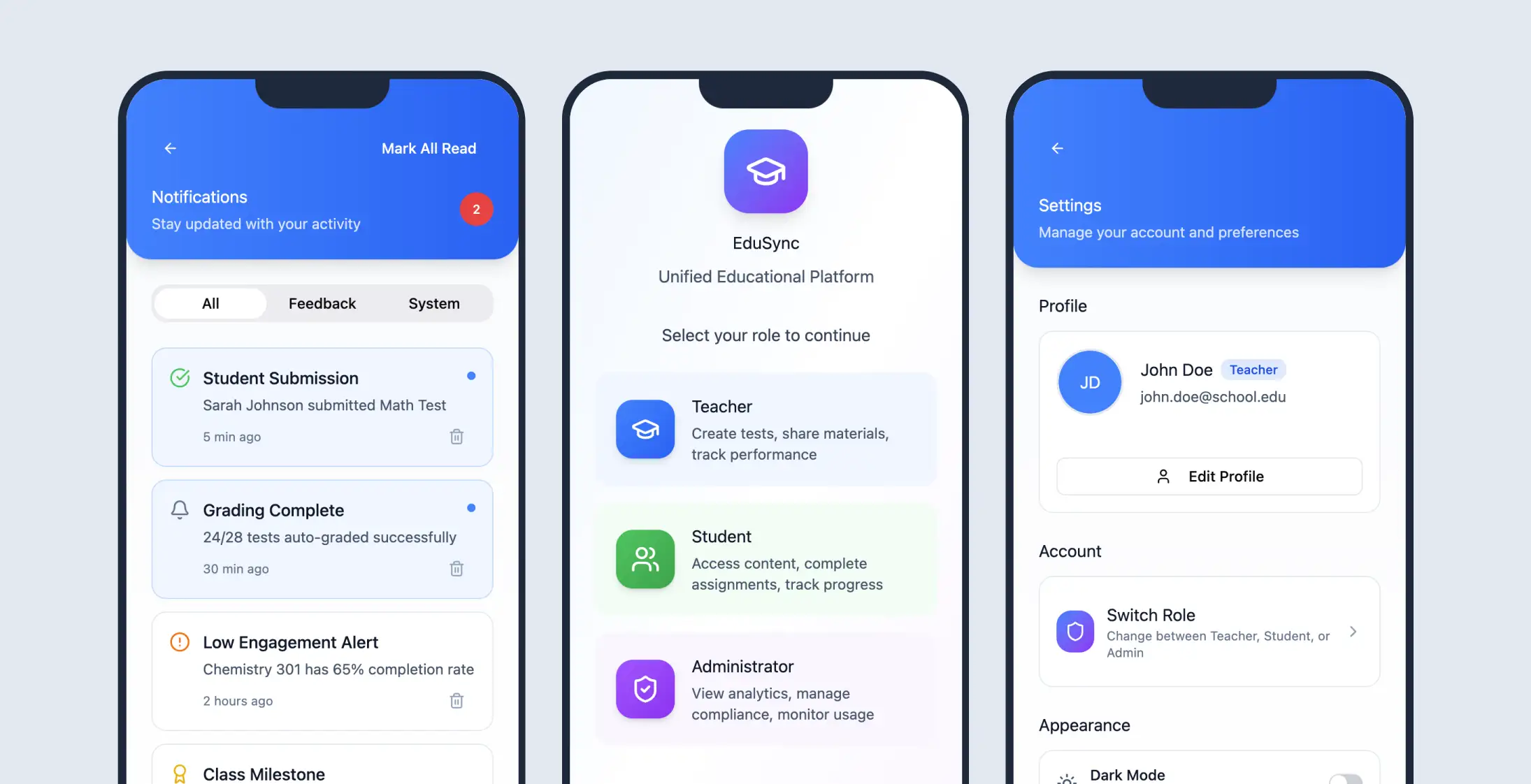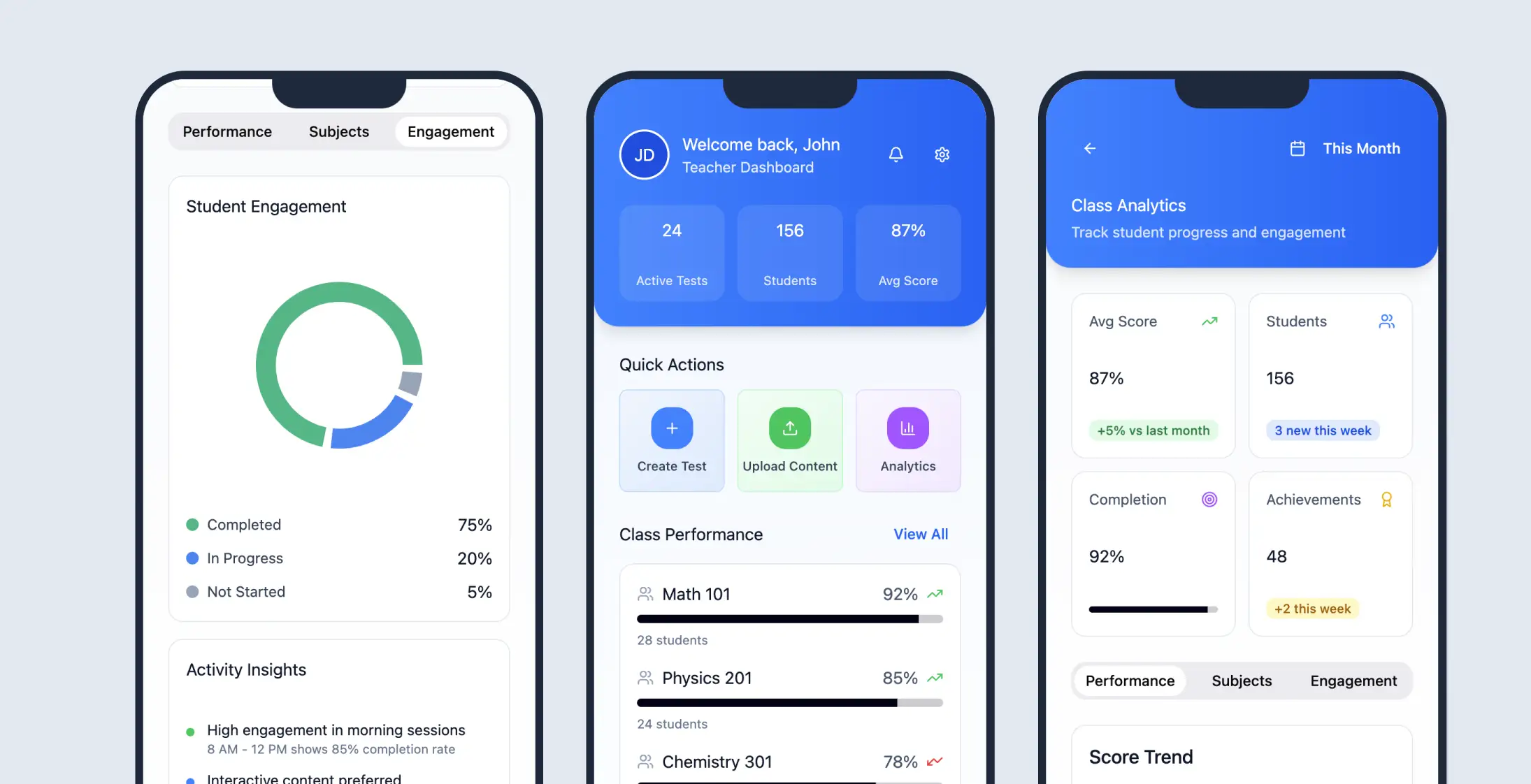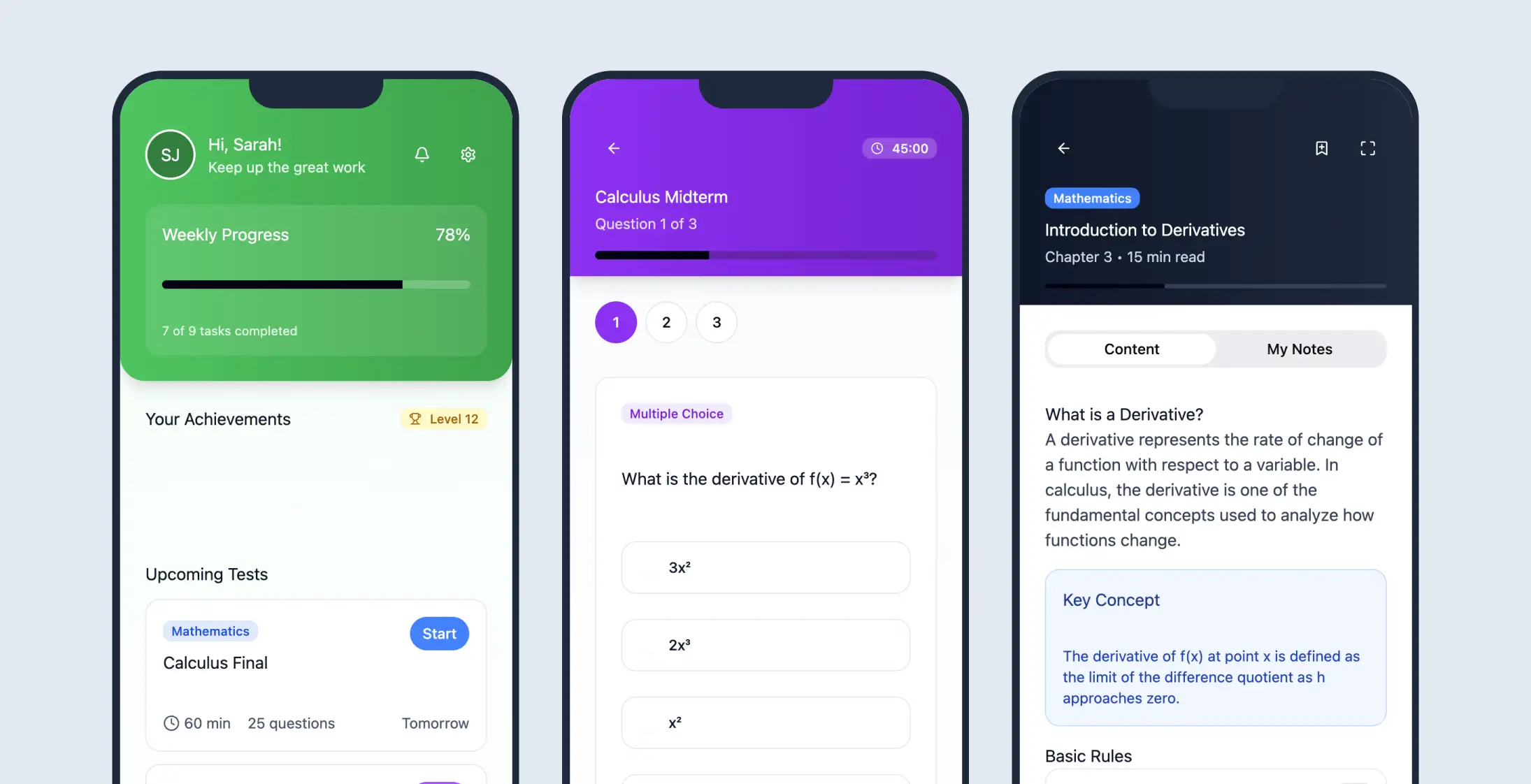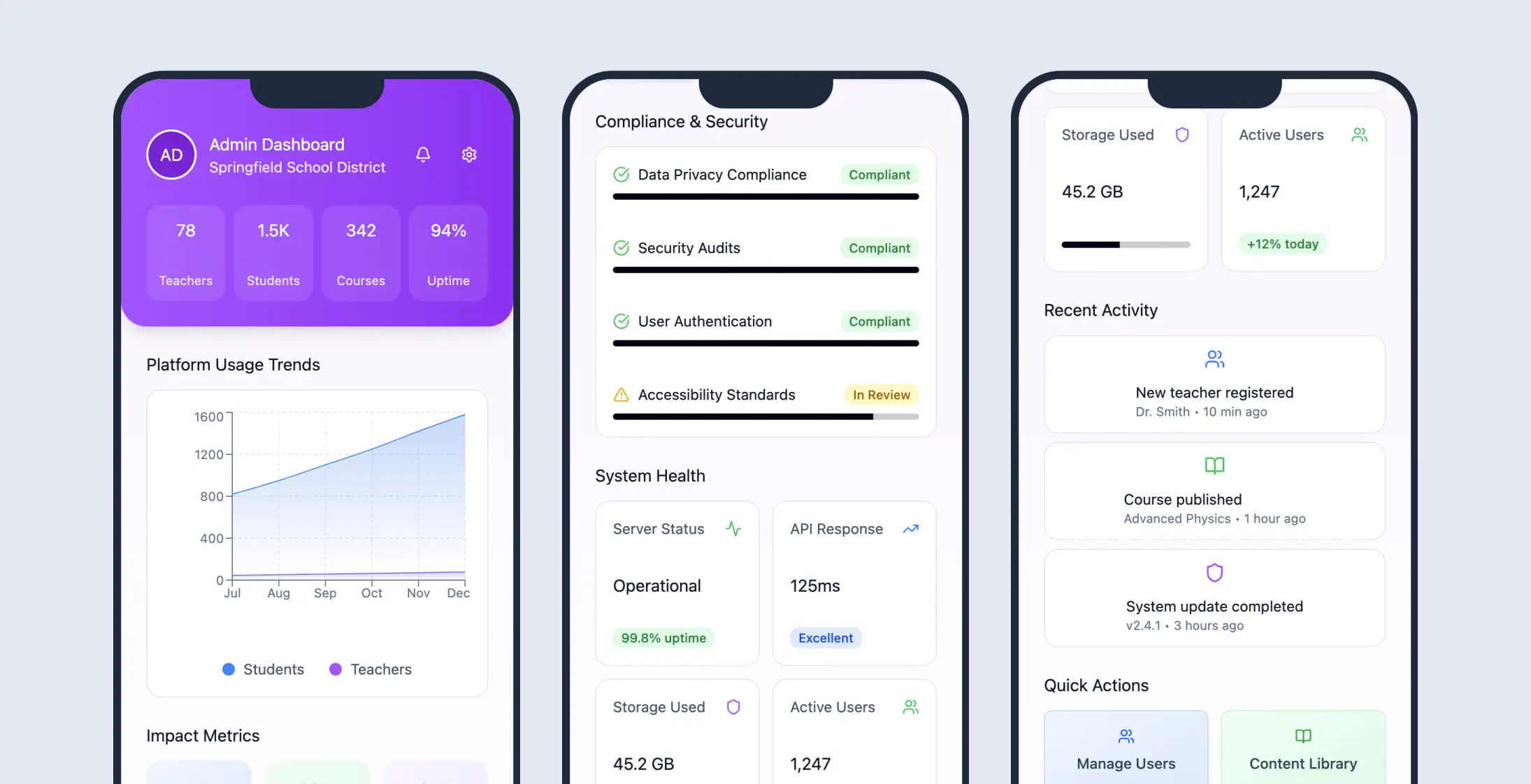



Project Overview
Educational institutions struggled with using tools for assessments and tracking progress in interactive learning. This led to increased work and a subpar user experience.
Solution Implementation
Implemented a system that combines testing modules with learning resources and performance analytics in one platform with role-based dashboards through blockchain consulting.
Results achieved:
- An 85% decrease in assessment setup time
- A 92% boost in student engagement metrics
- A 67% cut in administrative workload
Real-time progress monitoring systems along with automated assessment tools and tailored learning routes through AI blockchain integration significantly improve achievements in educational institutions.
Industry Challenges and Market Demands
The field of technology has undergone changes recently due to the increased need for remote learning solutions. Traditional schools have faced challenges in managing tools used for delivering content and assessing student progress effectively.
Teaching Challenges
Teachers had to manage multiple platforms for various tasks:
- Creating tests and assessments
- Sharing educational materials
- Monitoring student performance
Student Experience Issues
Students encountered difficulties with:
- Navigating multiple tools and systems
- Inconsistent user experiences
- Confusion leading to decreased participation levels
Transform Your Educational Technology
Streamline assessment, content delivery, and analytics in one unified platform.
Technical Infrastructure Requirements
Educational institutions needed a comprehensive solution that could:
- Combine assessment features with learning material delivery
- Provide analytics for both teachers and students
- Accommodate various types of assessments from multiple choice to complex project evaluations
- Maintain academic honesty and accessibility guidelines
System Integration Challenges
The disjointed educational tech environment caused several issues:
- Teachers switching between multiple platforms for different tasks
- Administrative work consuming valuable teaching time
- Limited meaningful interactions with students
- Inconsistent user experiences affecting learning goals
Data Management and Security Concerns
Data Silos Problem
Schools and colleges faced difficulties with data silos that hindered:
- Creation of comprehensive reports on student learning progress
- Overall institutional performance tracking
- Timely support for struggling students
- Efficient feedback delivery (manual grading caused delays)
Security and Compliance Issues
The increased focus on security was driven by:
- Necessity to oversee authentication systems
- Different levels of access control across platforms
- Challenges adhering to educational privacy regulations
- Student data scattered among multiple vendors and systems
Platform Benefits and Outcomes
Administrative Efficiency
Streamlined administrative tasks by removing the requirement for teachers to handle multiple platforms:
- 85% decrease in assessment creation time
- Enabled educators to concentrate on teaching instead of technical issues
Enhanced Student Engagement
The cohesive user interface and gaming features resulted in:
- 92% rise in engagement levels
- 40% increase in time students dedicated to learning tasks
- Real-time progress monitoring leading to 28% boost in test scores
- 45% decrease in course dropout rates
Institutional Benefits
Centralized reporting and analytics provided:
- 67% reduction in administrative burden
- Better decision-making on curriculum efficiency
- Improved resource distribution
- Automated grading reducing feedback time from days to minutes
Integrated proctoring features and plagiarism detection decreased instances of academic dishonesty by 73% while maintaining accessibility standards.
Cost Optimization
- 52% reduction in software expenses compared to using separate solutions
- Consolidated platform licenses reduced overall technology costs
System Architecture and Design
Core Platform Design
The platform focused on establishing an environment that smoothly merged:
- Evaluation tools with content distribution
- Analytical functions with user-friendly interfaces
- Role-based access across different user types
- Adaptability for various educational approaches
Technical Framework
The enterprise blockchain infrastructure provided:
System Components
| Component | Function | Technology |
|---|---|---|
| API Gateway Layer | Authentication and request management | OAuth 2, SAML integration |
| User Management Service | Role-based access control | Custom permissions system |
| Assessment Engine | Question formats and testing algorithms | Real-time scoring |
| Content Management | Module storage and CDN distribution | Multimedia support |
| Dashboard Service | Customized role-based interfaces | Reporting widgets |
| Notification System | Multi-channel communication | Email, SMS, in-app |
Security and Compliance Features
The system incorporated comprehensive security measures:
- End-to-end encryption for data protection
- FERPA and GDPR compliance
- Audit logs for activity monitoring
- COPPA guideline adherence
Integration Capabilities
Third-Party Connections
The Integration Hub offers:
- APIs and webhooks for LMS connectivity
- Student Information Systems (SIS) integration
- External tool compatibility
- Data transformation features
Database Architecture
The data structure incorporated:
- Mixed databases for organized information
- Document repositories for content management
- Time series databases for analytics
- Real-time synchronization across services
Performance and Scalability
High-Availability Features
During peak times like exam periods, the system maintains performance through:
- Load balancing and automatic scaling
- Geographic content distribution
- Optimized speed through content delivery networks
- Consistent performance during high-traffic periods
Development and Deployment
Implementation Approach
The project used an agile approach with:
- Updates prioritizing essential functions first
- Advanced features and organizational customizations following
- Integration and deployment practices
- System reliability maintenance
Testing and Quality Assurance
Comprehensive testing covered:
- Load testing for concurrent user capacity
- Security testing for vulnerability assessment
- Accessibility compliance with WCAG 2.0 standards
- Usability testing with real students and teachers
Performance enhancement requires ongoing optimization of database queries, caching implementation, and content compression for faster loading times.
Migration and Rollout Strategy
Phased Implementation
The migration plan involved:
- Starting with pilot programs in select institutions
- Gradual scaling to full implementation
- Gathering feedback and confirming performance standards
- Smooth transitions without disruptions or data loss
Disaster Recovery and Backup
Safety measures included:
- Circuit breakers and backup plans for service disruptions
- Real-time operational monitoring and alert systems
- Disaster recovery protocols with 4-hour recovery goals
- Comprehensive backup plans for point-in-time recovery
Performance Metrics and Results
Student Engagement Improvements
The platform transformation led to significant enhancements:
- Participation time increased from 45 minutes to 63 minutes per session
- Assessment completion rates rose from 78% to 94%
- Smoother testing procedures and enhanced user satisfaction
Teacher Productivity Gains
Teachers showed substantial improvements:
- Assessment creation time reduced from 2.5 hours to 22 minutes per test
- Automated feedback delivery replacing 48-hour wait times
- Same-day feedback on subjective evaluations
Educational Impact
Analysis of student performance data showed:
- More consistent engagement patterns throughout courses
- Increased retention rates and satisfaction levels
- 89% reduction in manual compliance reporting work
- Better accuracy in academic progress data submission
Project Results
- 85% decrease in assessment setup time
- 92% boost in student engagement metrics
- 67% cut in administrative workload
- 73% reduction in academic dishonesty
- 52% reduction in software expenses
Key Performance Metrics
Assessment Setup Reduction
Time saved in assessment creation
Student Engagement
Boost in engagement metrics
Administrative Efficiency
Reduction in workload
Cost Savings
Software expense reduction
Lessons Learned and Future Considerations
User Experience Consistency
Consistency in user experience proved crucial:
- Interface pattern standardization across user roles
- Navigation variations between student and teacher interfaces required attention
- Additional training time needed when interfaces differed significantly
Integration Complexity
Third-party system connections presented challenges:
- Varying API standards among educational technology vendors
- Different authentication methods increased complexity
- Need for comprehensive API documentation review in planning stages
Scalability Planning
Initial scalability planning required improvements:
- Unexpected usage levels during exam periods
- Need for predictive scaling using academic schedule markers
- Database performance optimization during concurrent testing
Mobile device usage exceeded expectations, highlighting the need for mobile optimization and progressive web app implementation for seamless cross-device experiences.
Technical Stack Overview
Frontend Technologies
- React.js with TypeScript for type safety and maintainable component structure
Backend Infrastructure
- PostgreSQL for primary data storage
- MongoDB for content management
- Redis for session management and caching
Container and Orchestration
- Docker containers managed through Amazon Elastic Kubernetes Service (Amazon EKS)
Monitoring and Security
- Prometheus for metrics collection
- Grafana for visualization
- ELK stack for centralized logging
- AWS IAM, OAuth 2.0, and JWT for authentication
Development Pipeline
- GitLab CI/CD integration with automated testing and deployment workflows
This comprehensive educational technology platform successfully addressed the fragmented nature of educational tools by providing a unified, scalable solution that improved efficiency, engagement, and educational outcomes across institutions.


